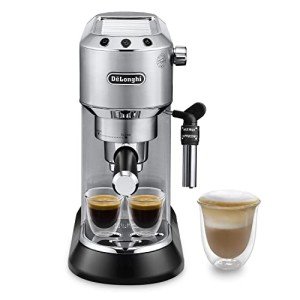The Ultimate Guide to Cappuccino Machines: Brewing the Perfect Cup
Cappuccinos are a beloved coffee beverage that integrates the abundant flavors of espresso with steamed milk and milk foam. For numerous, nothing tastes better than a homemade cappuccino crafted with precision. Nevertheless, reproducing the skill of a barista in your home needs the right equipment. This is where cappuccino machines enter play. This post looks into the different kinds of cappuccino machines, how they work, and ideas for picking the very best one for your needs.
What is a Cappuccino Machine?
A cappuccino machine is a specific developing device designed to make cappuccinos and other espresso-based beverages. These machines generally feature a built-in espresso maker, a milk frother, and various controls for adjusting temperature and pressure. Cappuccino machines can be manual, semi-automatic, or totally automatic, providing various levels of user control depending on the complexity of the machine.
Types of Cappuccino Machines
1. Manual Espresso Machines
- Description: These machines need users to run most functions manually, including grinding coffee beans, tamping the grounds, pulling the espresso shot, and frothing the milk.
- Pros:
- Offers complete control over the developing procedure.
- Can produce high-quality, café-like espresso.
- Cons:
- Steeper learning curve.
- Needs more time and effort.
2. Semi-Automatic Espresso Machines
- Description: Semi-automatic machines automate some processes, such as water pressure. Users still require to grind coffee and froth milk by hand.
- Pros:
- Balanced control and benefit.
- Permits room for experimentation.
- Cons:
- Still requires useful abilities.
- Can be complicated for newbies.
3. Totally Automatic Espresso Machines
- Description: These machines automate the whole brewing procedure, from grinding to frothing. Heat Exchange Espresso Machines pick the preferred drink.
- Pros:
- Extremely practical and simple to use.
- Constant outcomes with little effort.
- Cons:
- More pricey.
- Limited control over the developing process.
4. Super Automatic Espresso Machines
- Description: Similar to fully automatic machines, however these models consist of functions like an integrated milk frother and grinder. They prepare drinks with simply the touch of a button.
- Pros:
- Ultimate benefit; makes various drinks rapidly.
- Integrated cleaning and maintenance features.
- Cons:
- High initial expense.
- Less hands-on experience with coffee making.
Key Features to Consider
When picking a cappuccino machine, a number of functions can substantially influence performance and user experience. Here are some necessary elements to evaluate:
1. Construct Quality
- Products used (stainless steel, plastic)
- Durability and durability
2. Capability
- Water reservoir size
- Bean hopper capability
3. Frothing Capability
- Type of frothing wand (manual, automatic)
- Steam pressure and temperature control
4. Alleviate of Use
- Instinctive controls
- Cleaning up and upkeep requirements
5. Price
- Variety from budget to high-end models
- Consider warranties and client assistance alternatives
6. Brand name Reputation
- User reviews and skilled opinions
- Accessibility of replacement parts
The Brewing Process
To brew the best cappuccino in the house, follow this procedure, despite the machine type:
- Prepare the Espresso: Use newly ground coffee beans and pull a double shot (around 2 ounces) of espresso.
- Froth the Milk: Steam fresh milk to a temperature about 150 ° F( 65 ° C)using the steam wand or automatic frother.
- Combine: Pour the steamed milk over the espresso, followed by a layer of milk foam (equivalent parts espresso and steamed milk, with about 1 cm of foam).
For a visual representation, here's a basic table comparing the characteristics of the cappuccino machine types:
| Machine Type | Control Level | Reduce of Use | Cost Range | Perfect For |
|---|---|---|---|---|
| Manual Espresso Machine | High | Tough | Low to Medium | Coffee enthusiasts, purists |
| Semi-Automatic Machine | Medium | Moderate | Medium | Home baristas, hobbyists |
| Fully Automatic Machine | Low | Easy | Medium to High | Casual drinkers |
| Super Automatic Machine | Really Low | Really Easy | High | Busy experts |
Often Asked Questions (FAQs)
What is the best milk to use for cappuccinos?
Whole milk is typically chosen for frothing due to its fat content, which develops a creamy texture. However, alternatives like almond milk, oat milk, or soy milk can be utilized, though they might require various frothing methods.
How do I clean my cappuccino machine?
Most machines feature specific cleansing guidelines. Typically, you need to regularly clean up the group head, steam wand, and drip tray. For White Espresso Machines , many models include self-cleaning cycles.
Can I use pre-ground coffee rather of entire beans?
Yes, you can use pre-ground coffee. Nevertheless, freshly ground coffee usually produces a more delicious espresso due to the oils in the beans being preserved.
Just how much should I invest on a cappuccino machine?
The rate varies considerably based on features, brand name, and quality. A standard, excellent quality machine may start around ₤ 200, while high-end super automatic machines can surpass ₤ 2,000.
How typically should I replace my cappuccino machine?
With proper upkeep, a high-quality cappuccino machine can last for several years. However, you may think about upgrading if you discover your machine no longer meets your developing needs or experiences performance problems.
Cappuccino machines are powerful allies in providing the ideal brew in your home. Whether you favor manual interaction with your coffee or prefer the benefit of fully automated machines, understanding the various types and their features will help you in making the ideal choice. By buying the perfect machine for your needs and using the right methods, anybody can take pleasure in a barista-quality cappuccino from the comfort of their own cooking area. With a little patience and imagination, the art of cappuccino developing can become a delightful routine, brewing not just coffee however moments of joy.

